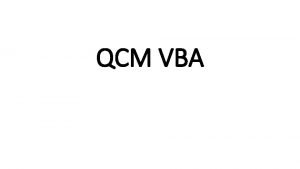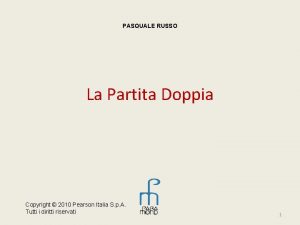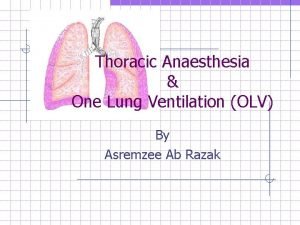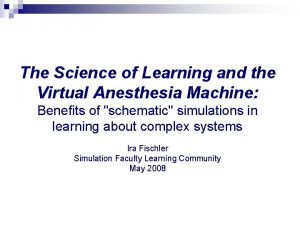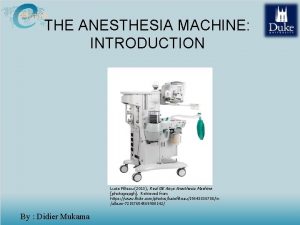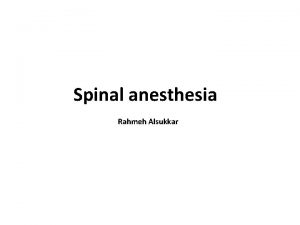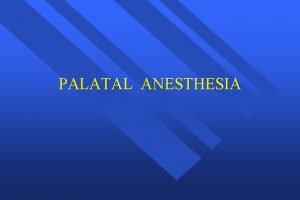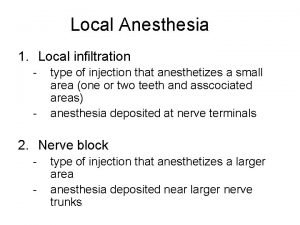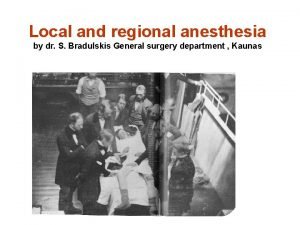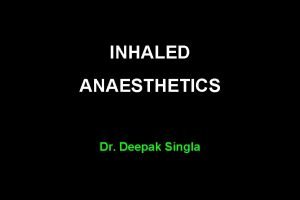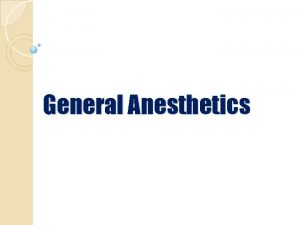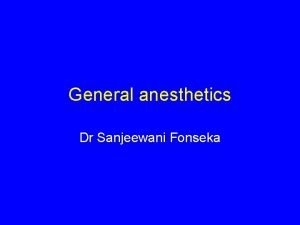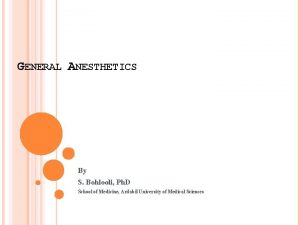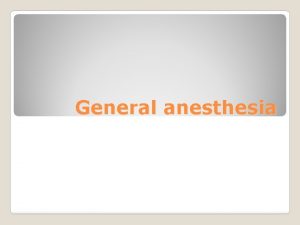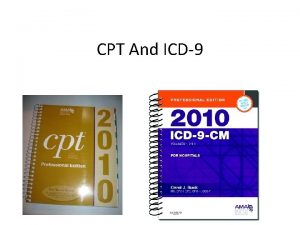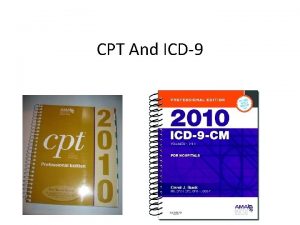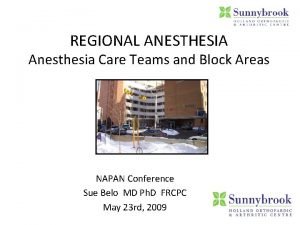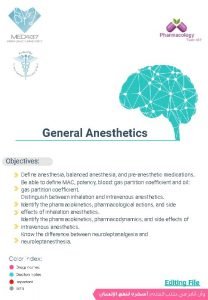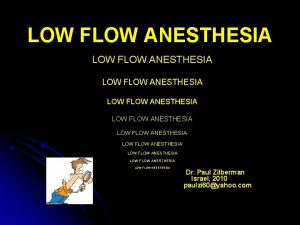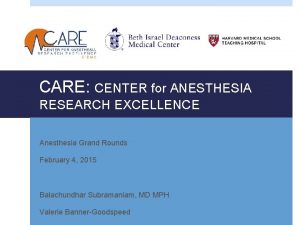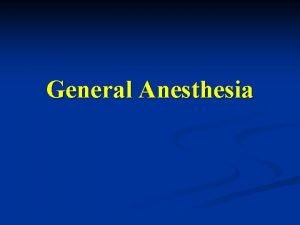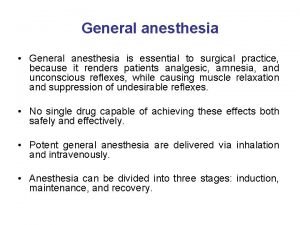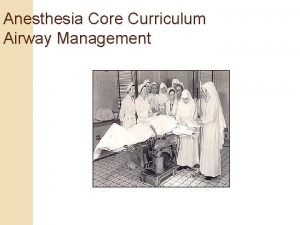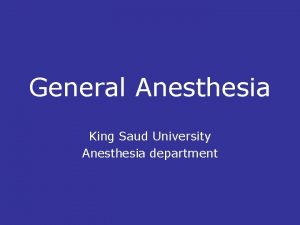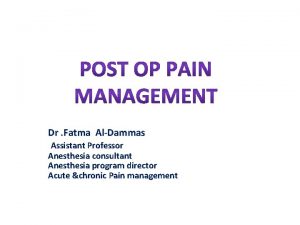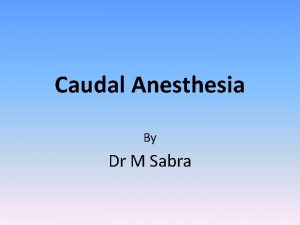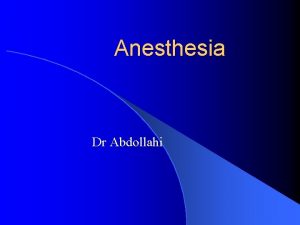Anesthesia Chapter 16 CPT Copyright CPT copyright 2010



































- Slides: 35

Anesthesia Chapter 16

CPT® Copyright CPT® copyright 2010 American Medical Association. All rights reserved. Fee schedules, relative value units, conversion factors and/or related components are not assigned by the AMA, are not part of CPT®, and the AMA is not recommending their use. The AMA does not directly or indirectly practice medicine or dispense medical services. The AMA assumes no liability for data contained or not contained herein. CPT is a registered trademark of the American Medical Association.

Objectives • • Understand anesthesia coding guidelines Define key terms related to anesthesia Determine Total Anesthesia Units Identify when other services may be billed in conjunction with anesthesia • Anesthesia Physical Status Modifiers • Qualifying Circumstances • Common Modifiers

Definition Anesthesia is a state in which the patient feels no pain

Organization of Codes Organized by anatomical location • • • Head (00100 -00222) Neck (00300 -00352) Thorax (00400 -00474) Intrathoracic (00500 -00580) Spine and Spinal Cord (0060000670) Upper Abdomen (00700 -00797) Lower Abdomen (00800 -00882) Perineum (00902 -00952) Pelvis (01112 -01190) Upper Leg (01200 -01274) Knee and Popliteal Area (0132001444) • • Lower Leg (01462 -01522) Shoulder and Axilla (01610 -01682) Upper Arm and Elbow (0171001782) Forearm, Wrist, and Hand (0181001860) Radiological Procedures (0191601936) Burn Excisions or Debridement (01951 -01953) Obstetric (01958 -01969) Other Procedures (01990 -01999)

Finding The CPT® Code • Start in the Index • Look up Anesthesia • Anatomical location • Type of surgery • Surgical approach

Corneal Transplant 1. In the Index – Anesthesia Corneal Transplant 00144 2. In the Tabular Look at 00144 – Anesthesia for procedures on eye; corneal transplant

Example: Thyroid Biopsy 1. In the Index – Anesthesia Biopsy 00100 00702 Liver OR – Anesthesia Thyroid 00320 -00322 2. In the Tabular After reviewing 00320 – 00322 Was it a needle biopsy (00322)?

Example: Removal Lobe of The Lung 1. In the Index – Anesthesia Lung 00522, 00539, 00540 -00548 2. In the Tabular – – 00540 Anesthesia for thoracotomy procedures involving lungs, pleura, diaphragm, and mediastinum (including surgical thoracoscopy); not otherwise specified 00541 utilizing 1 lung ventilation

Example: Spinal Cord Biopsy 1. In the Index – Anesthesia Spine and Spinal Cord Lumbar 00600 -00604, 00620, 00670 00630 -00635, 00640, 00670 2. In the Tabular – 00630 Anesthesia for procedures in the lumbar region; not otherwise specified

Example: Arthroscopic Procedure - Knee 1. In the Index – Anesthesia Arthroscopic procedures Knee 01382, 01400 2. In the Tabular – – 01382 Anesthesia for diagnostic arthroscopic procedures of knee joint 01400 Anesthesia for open or surgical arthroscopic procedures on knee joint; not otherwise specified

Types of Anesthesia • Local – Included in CPT® code – No separate anesthesia code • MAC - Monitored Anesthesia Care – Decreased awareness • Regional – Blocks – Spinals – Epidurals • General – Unconscious

Anesthesia Terminology • One-Lung Ventilation (OLV) – occurs when one lung is ventilated and the other lung is collapsed temporarily – improve surgical access to the lung • Pump Oxygenator – Bypass machine patients are placed on during cardiac procedures. – Would find information included in the anesthesia note.

Anesthesia Terminology • Intraperitoneal – within the peritoneum – Upper abdomen - stomach, liver, gallbladder, spleen, jejunum, ascending and transverse colon – Lower abdomen - appendix, cecum, ileum and sigmoid colon • the cecum and ileum are part of the small intestines and originate in the upper abdomen, these may be coded as upper abdomen • Extraperitoneal/Retroperitoneal - space in the abdominal cavity behind the peritoneum – Upper abdomen - kidneys and adrenal glands and lower esophagus – Lower abdomen - ureter and urinary tract – aorta and inferior vena cava

Anesthesia Guidelines • Services included with the anesthesia code: – – – Preoperative visits Postoperative visits Anesthesia during the procedure Administration of fluids/blood Usual monitoring • Unusual forms include CVP, Arterial line insertion, and Swanz-Ganz and are coded separately

Coders’ Tools • CPT® manual - AMA • Anesthesia Crosswalk - ASA • Organized by procedure code • Anesthesia Relative Value Guide - ASA • Numeric ranking of a procedure • Base units NOTE: You are NOT required to have the Anesthesia Crosswalk or the Anesthesia Relative Value Guide published by the ASA for this course.

Fee Formula • RVU • Anesthesia time • Listed in your Anesthesia Guidelines in your CPT® Coding Manual • Begins when patient is prepared • Ends when personal attendance not required • Unit of time – 15 minutes • 8 x 15 = 2 hours • May vary based on insurance contracts • Additional Units

Physical Status Modifiers • Assigned by the provider • Coder would need to look for a diagnosis to report it • Documented in anesthesia record P 1 P 2 P 3 P 4 P 5 P 6 - normal healthy mild systemic disease severe systemic disease (1 unit) constant threat to patients life (2 units) not expected to survive w/o surgery (3 units) declared brain-dead patient

Qualifying Circumstances • + 99100 – under 1 or over 70 • Additional 1 unit • + 99116 - complicated by hypothermia • Additional 5 units • + 99135 - complicated by controlled hypotension • Additional 5 units • + 99140 - complicated by emergency • Additional 2 units

Example #1 00326 - Anesthesia for all procedures on larynx and trachea in children younger than 1 year of age – Age included – not appropriate to use 99100 – Parenthetical instruction stating not to use 99100 in conjunction with 00326

Example #2 00561 – Anesthesia for procedures on heart, pericardial sac, and great vessels of the chest; with pump oxygenator, younger than 1 year of age – Age included – not appropriate to use 99100 – Parenthetical instruction stating not to use 99100, 99116, and 99135 in conjunction with 00561

Specificity of Codes • Type of procedure • Age of patient • Re-operation timing • Examples of detailed anesthesia codes – 00562 – Anesthesia for procedures on heart, pericardial sac, and great vessels of chest; with pump oxygenator, age 1 year or older, for all non-coronary bypass procedures (eg, valve procedures) or for reoperation for coronary bypass more than 1 month after original operation. – 00211 - Anesthesia for intracranial procedures; craniotomy or craniectomy for evacuation of hematoma

Adding It All Up • Base Values (aka Relative Values/RVU) • Time units – 15 minutes • Modifying Units • Physical Status Modifiers • Qualifying Circumstances

Adding It All Up • Medicare: – base value + time units = total units – does not give additional units. • Commercial Payers (depending on contract: – base value + time units + modifying units = total units

Example: Biopsy of Thyroid Medicare Base value 2 hrs (120 min/15) Total Units 4 8 12 x Conversion Factor Commercial Base value 2 hrs (120 min/15) P 3 Status Modifier Total Units 4 8 1 13 x Conversion Factor

Fee Equation • Providers conversion factor $25. 00 – Medicare $25. 00 X 12 Units $300. 00 fee billed to Medicare – Commercial $25. 00 X 13 Units $325. 00 fee other payer

Anesthesia Guidelines: Separate or Multiple Procedures • Only one anesthesia code is selected • Exception – anesthesia add on codes – Example: +01968 Anesthesia for cesarean delivery following neuraxial labor analgesia/anesthesia • Report most extensive or most complex • Use total anesthesia time for all procedures

Anesthesia Guidelines: Separate or Multiple Procedures Example: – 01630 – Anesthesia for open or surgical arthroscopic procedures on humeral head and neck, sternoclavicular joint, acromioclavicular joint, and shoulder joint; not otherwise specified. – 01820 – Anesthesia for all closed procedures on radius, ulna, wrist, or hand bones Only report 01630 – use time for both procedures.

Modifiers HCPCS Level II AA - Performed by anesthesiologist AD - Medically supervised by physician QK - Medically directing 2 -4 concurrent procedures (cases happening at the same time) QS - MAC (deep sedation) QX - CRNA service medically directed QY - medically directing CRNA single case QZ - CRNA w/o medical direction

Medicare Policy QK modifier - Medical Direction of 2 -4 concurrent procedures – Must document • • Pre-anesthetic exam and evaluation Prescribe anesthesia plan Personally provide any demanding parts Qualified Individual Monitor the course at frequent intervals Remain present and available for Provide postoperative care

CPT® Modifiers • 53 – Discontinued Procedures – Used if surgeon discontinues the procedure • 59 - Distinct procedural services – Example: General anesthesia during surgery, then an epidural is placed for post op pain management.

Anesthesia Review • • • Determine the surgical procedure Locate in Index under Anesthesia Locate in Tabular index Identify provider Locate correct modifiers – HCPCS/CPT – Physical Status – Qualifying Circumstances

Anesthesia Time Review • Calculate anesthesia time: + Base units + Time units + Additional Units » Status modifier » Qualifying Circumstances = Total units

Additional Procedures • CVP – central venous catheter (36555, 36556) – Monitoring – Quick administration • Arterial Line Insertion (36620, 36625) – Based on technique used • Swan-Ganz (93503) – Included if done through the CVP – Separate vessels code for both

Conclusion • Important to understand – Anatomic location – Type of procedure being performed • When looking up in the index, start with the word “Anesthesia”
 Vba
Vba 2010 pearson education inc
2010 pearson education inc Copyright 2010
Copyright 2010 Variazioni finanziarie attive e passive
Variazioni finanziarie attive e passive Copyright 2010 pearson education inc
Copyright 2010 pearson education inc Copyright 2010 pearson education inc
Copyright 2010 pearson education inc Copyright 2010
Copyright 2010 Nwoz
Nwoz Copyright 2010 pearson education inc
Copyright 2010 pearson education inc Copyright 2010 pearson education inc
Copyright 2010 pearson education inc Copyright 2010 pearson education inc
Copyright 2010 pearson education inc Copyright 2010 pearson education inc
Copyright 2010 pearson education inc Copyright 2010 pearson education inc
Copyright 2010 pearson education inc Copyright 2010 pearson education inc
Copyright 2010 pearson education inc Pearson education inc all rights reserved
Pearson education inc all rights reserved Double lumen tube sizing
Double lumen tube sizing Virtual anesthesia machine
Virtual anesthesia machine Fail safe valve anesthesia
Fail safe valve anesthesia Hanger yoke anesthesia machine
Hanger yoke anesthesia machine Structures pierced by spinal needle
Structures pierced by spinal needle Pre anesthesia assessment form
Pre anesthesia assessment form Greater palatine nerve block landmarks
Greater palatine nerve block landmarks Trigeminal
Trigeminal Mechanism of local anesthesia
Mechanism of local anesthesia Local anesthesia
Local anesthesia Incisive nerve block
Incisive nerve block Bier
Bier Sanjita das
Sanjita das Nasal trumpet measurement
Nasal trumpet measurement Mac isoflurane
Mac isoflurane Inhalation anesthetics
Inhalation anesthetics Components of anaesthesia
Components of anaesthesia Classification of inhalational agents
Classification of inhalational agents Classification of inhalational agents
Classification of inhalational agents General anesthesia drugs dosage
General anesthesia drugs dosage Reverse neuromuscular blockade
Reverse neuromuscular blockade
